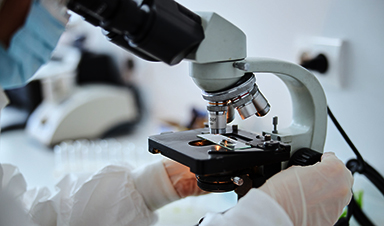How can a drug be delivered exactly where it is needed, while limiting the risk of side effects? The use of nanoparticles to encapsulate a drug to protect it and the body until it reaches its point of action is being increasingly studied. However, this requires identifying the right nanoparticle for each drug according to a series of precise parameters.
These results, recently published in the Journal of Controlled Release, open the way to an extremely powerful and targeted anti-inflammatory treatment.
Inflammation is an essential physiological response of the body to defend itself against pathogens such as bacteria. It can however become problematic when it turns into a chronic condition, such as in cancers, autoimmune diseases or certain viral infections.
Many treatments already exist, but their action is often not very targeted, high doses are required and deleterious side effects are frequent. Macrophages, large immune cells whose natural function is to absorbs pathogens and trigger inflammation to destroy them, are often involved in inflammatory diseases. When overactivated, they trigger an excessive inflammatory response that turns against the body instead of protecting it.
Necrosulfonamide (NSA) is a new molecule that inhibits the release of several important pro-inflammatory mediators, therefore constituting a promising advance to reduce certain types of inflammation. However, being extremely hydrophobic in nature, it travels poorly in the bloodstream and could target many cell types, triggering potentially toxic effects.
“This is why this molecule is not yet available as a drug,” says Gaby Palmer, a professor in the Department of Medicine and the Geneva Center for Inflammation Research at the UNIGE Faculty of Medicine, who codirected the study. “Using a nanoparticle as a transport vessel would circumvent these shortcomings by delivering the drug directly into macrophages to combat inflammatory overactivation in the place where it begins.”
Three nanoparticles under the microscope
“We used an in vitro screening technology which we developed a few years ago on human and mouse cells. This saves time and greatly reduces the need to use animal models,” explains Carole Bourquin, a professor at the UNIGE’s Faculties of Science (Institute of Pharmaceutical Sciences of Western Switzerland) and Medicine (Department of Anesthesiology, Pharmacology, Intensive Care and Emergencies, Translational Research Center in Oncohematology, Geneva Center for Inflammation Research), who codirected this work at UNIGE. ‘”Thus, only the most promising particles will then be tested on mice, which is a prerequisite for clinical trials on humans.”
Three very different nanoparticles featuring high porosity were examined: a cyclodextrin-based nanoparticle, a substance commonly used in cosmetics or industrial food, a porous magnesium phosphate nanoparticle, and finally a porous silica nanoparticle. “The first was less satisfactory in cell uptake behavior, while the second proved to be counterproductive: it triggered the release of pro-inflammatory mediators, stimulating the inflammatory reaction instead of fighting it,” says Bart Boersma, a doctoral student in Carole Bourquin’s laboratory and first author of this study.
‘”The porous silica nanoparticle, on the other hand, met all the criteria: it was fully biodegradable, of the right size to be swallowed by macrophages, and was able to absorb the drug into its numerous pores without releasing it too early. The anti-inflammatory effect was remarkable.” The team then replicated their tests by coating the nanoparticles with an additional layer of lipid, but with no greater benefit than silica nanoparticles alone.
Tiny silica sponges
Other silica nanosponges developed by the German-Swiss team had already proven their effectiveness in transporting anti-tumor drugs. “Here, they carry a very different drug that inhibits the immune system,” says Carole Bourquin.
“Mesoporous silica is increasingly revealing itself as a nanoparticle of choice in the pharmaceutical field, as it is very effective, stable and non-toxic. Nevertheless, each drug requires a tailor-made carrier: the shape, size, composition and destination of the particles must be reassessed each time.”
The combination of this potent anti-inflammatory drug and these mesoporous silica nanoparticles shows a promising synergism to be further studied by the team.
Image Credit: Envato Elements
News
Lower doses of immunotherapy for skin cancer give better results, study suggests
According to a new study, lower doses of approved immunotherapy for malignant melanoma can give better results against tumors, while reducing side effects. This is reported by researchers at Karolinska Institutet in the Journal of the National [...]
Researchers highlight five pathways through which microplastics can harm the brain
Microplastics could be fueling neurodegenerative diseases like Alzheimer's and Parkinson's, with a new study highlighting five ways microplastics can trigger inflammation and damage in the brain. More than 57 million people live with dementia, [...]
Tiny Metal Nanodots Obliterate Cancer Cells While Largely Sparing Healthy Tissue
Scientists have developed tiny metal-oxide particles that push cancer cells past their stress limits while sparing healthy tissue. An international team led by RMIT University has developed tiny particles called nanodots, crafted from a metallic compound, [...]
Gold Nanoclusters Could Supercharge Quantum Computers
Researchers found that gold “super atoms” can behave like the atoms in top-tier quantum systems—only far easier to scale. These tiny clusters can be customized at the molecular level, offering a powerful, tunable foundation [...]
A single shot of HPV vaccine may be enough to fight cervical cancer, study finds
WASHINGTON -- A single HPV vaccination appears just as effective as two doses at preventing the viral infection that causes cervical cancer, researchers reported Wednesday. HPV, or human papillomavirus, is very common and spread [...]
New technique overcomes technological barrier in 3D brain imaging
Scientists at the Swiss Light Source SLS have succeeded in mapping a piece of brain tissue in 3D at unprecedented resolution using X-rays, non-destructively. The breakthrough overcomes a long-standing technological barrier that had limited [...]
Scientists Uncover Hidden Blood Pattern in Long COVID
Researchers found persistent microclot and NET structures in Long COVID blood that may explain long-lasting symptoms. Researchers examining Long COVID have identified a structural connection between circulating microclots and neutrophil extracellular traps (NETs). The [...]
This Cellular Trick Helps Cancer Spread, but Could Also Stop It
Groups of normal cbiells can sense far into their surroundings, helping explain cancer cell migration. Understanding this ability could lead to new ways to limit tumor spread. The tale of the princess and the [...]
New mRNA therapy targets drug-resistant pneumonia
Bacteria that multiply on surfaces are a major headache in health care when they gain a foothold on, for example, implants or in catheters. Researchers at Chalmers University of Technology in Sweden have found [...]
Current Heart Health Guidelines Are Failing To Catch a Deadly Genetic Killer
New research reveals that standard screening misses most people with a common inherited cholesterol disorder. A Mayo Clinic study reports that current genetic screening guidelines overlook most people who have familial hypercholesterolemia, an inherited disorder that [...]
Scientists Identify the Evolutionary “Purpose” of Consciousness
Summary: Researchers at Ruhr University Bochum explore why consciousness evolved and why different species developed it in distinct ways. By comparing humans with birds, they show that complex awareness may arise through different neural architectures yet [...]
Novel mRNA therapy curbs antibiotic-resistant infections in preclinical lung models
Researchers at the Icahn School of Medicine at Mount Sinai and collaborators have reported early success with a novel mRNA-based therapy designed to combat antibiotic-resistant bacteria. The findings, published in Nature Biotechnology, show that in [...]
New skin-permeable polymer delivers insulin without needles
A breakthrough zwitterionic polymer slips through the skin’s toughest barriers, carrying insulin deep into tissue and normalizing blood sugar, offering patients a painless alternative to daily injections. A recent study published in the journal Nature examines [...]
Multifunctional Nanogels: A Breakthrough in Antibacterial Strategies
Antibiotic resistance is a growing concern - from human health to crop survival. A new study successfully uses nanogels to target and almost entirely inhibit the bacteria P. Aeruginosa. Recently published in Angewandte Chemie, the study [...]
Nanoflowers rejuvenate old and damaged human cells by replacing their mitochondria
Biomedical researchers at Texas A&M University may have discovered a way to stop or even reverse the decline of cellular energy production—a finding that could have revolutionary effects across medicine. Dr. Akhilesh K. Gaharwar [...]
The Stunning New Push to Protect the Invisible 99% of Life
Scientists worldwide have joined forces to build the first-ever roadmap for conserving Earth’s vast invisible majority—microbes. Their new IUCN Specialist Group reframes conservation by elevating microbial life to the same urgency as plants and [...]





















